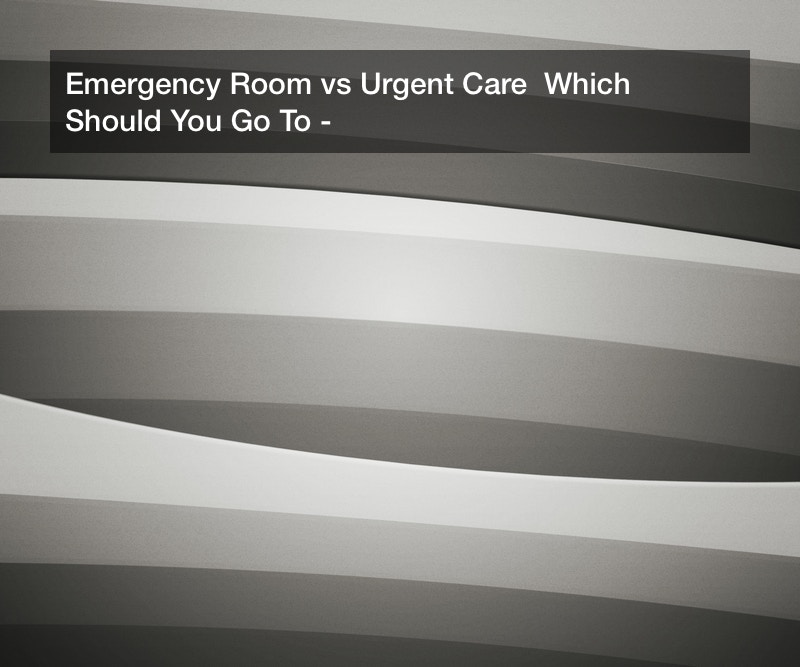No one enjoys being sick or hurt. Yet it happens all the time and often when you least expect it: you wake up in the middle of night with cold sweats and a fever; you stumble on an uneven spot on the sidewalk and roll an ankle; you move the wrong way and end up with intense pain in a hard-to-reach spot.
When any of those things happen, your first inclination might to seek out medical aid and that’s a good choice. But what happens if it’s the middle of the night? Your primary care doctor’s office is going to be closed and you may wrestle with whether or not you should go to the emergency room.
Another option is to go to one of your local urgent care locations. These urgent cares are essentially walk-in clinics that can act as a gap between the ER and your primary care doctor and can treat all kinds of non-life-threatening symptoms. In fact, more than three million people visit urgent cares every week.
But how do you know which one to go to? The best thing you can do No one enjoys being sick or hurt. Yet it happens all the time and often when you least expect it: you wake up in the middle of night with cold sweats and a fever; you stumble on an uneven spot on the sidewalk and roll an ankle; you move the wrong way and end up with intense pain in a hard-to-reach spot.
When any of those things happen, your first inclination might to seek out medical aid and that’s a good choice. But what happens if it’s the middle of the night? Your primary care doctor’s office is going to be closed and you may wrestle with whether or not you should go to the emergency room.
Another option is to go to one of your local urgent care locations. These urgent cares are essentially walk-in clinics that can act as a gap between the ER and your primary care doctor and can treat all kinds of non-life-threatening symptoms. In fact, more than three million people visit urgent cares every week.
But how do you know which one to go to? The best thing you can do is take stock of the situation and make a determination from there. In fact, there are many conditions that can be considered life-threatening and require advanced treatment in the ER. Symptoms that can require an ER trip can include:
- Weakness or numbness on one side of the body.
- Serious burns
- Injuries to the head or eyes
- Seizures
- High fevers that may include a rash
- Broken bones and dislocated joints
- Chest pain and breathing difficulty
- Concussions
- Severe cuts that usually require stitches
- Severe symptoms associated with the flu or a cold
- Changes in a person’s mental state
- In the case of women, pregnancy issues such as vaginal bleeding
If you’re deciding whether or not to make an ER visit, the best thing you can is to trust your instincts. If you think it’s serious, don’t wait. Act immediately. That includes making the decision to call 911. If you’re experiencing something like chest pains or fainting or a seizure, you or a loved one should call 911 right away rather than trying to drive yourself.
In the case of urgent care, it’s important to note that urgent care isn’t emergency care and it’s often been the case that people go to the ER for minor injuries and, while they are treated, they often end up waiting a long time to be treated for minor injuries and end up paying big bills. Urgent cares are same-day clinics that can handle an ever-growing variety of non-life-threatening medical issues that aren’t considered emergencies. Some symptoms your local urgent care can deal with include:
- Fevers with no rash
- Dehydration
- Muscle strains and sprains
- Small cuts
- Moderate symptoms associated with the flu and the common cold
- Shortness of breath or wheezing
- Sore throat
- Moderate eye issues
- Ear infections
- Moderate physical pain
- Persistent diarrhea or persistent vomiting
Again, the best thing you can do is trust your gut. If you feel symptoms coming on gradually or you can easily diagnose what’s happening to you or a loved one, then make a trip to an urgent care. It should be noted that an urgent care clinic isn’t and shouldn’t be a permanent replacement for your primary care physician, who knows your health history and what treatments work best for you.
But when you can’t get in to see your regular doctor, urgent care facilities are the next best option or minor or moderate medical issues. You don’t have to make appointments beforehand, you usually get in to see a doctor faster—wait time is usually about 15 minutes—and most urgent care facilities are open much later than regular doctors offices. Most urgent cares are open until at least 7 p.m. during the work week and many are open on the weekends.
When it comes to your health and seeking medical aid, the best thing you can do is trust your gut. Even if you’re in pain or feeling uncomfortable, take time to assess your situation and whether it is severe enough call 911 or go to the emergency room or moderate enough to visit a local urgent care.
